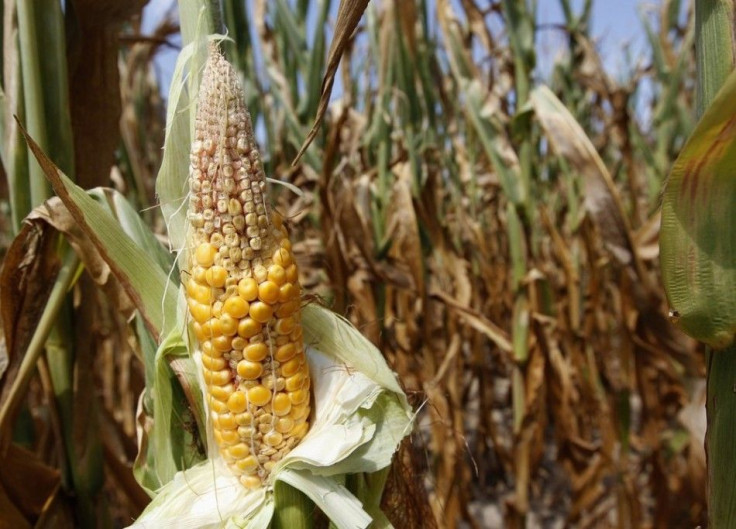Low US Crop Estimate Heightens Food Crisis Concerns
U.S. ethanol policy is in the crosshairs, again

As expected, the U.S. Department of Agriculture, or USDA, slashed its corn-yield forecast for the year.
Unexpected: the amount by which the forecast was slashed, from 13 billion bushels estimated just last month to 10.8 billion bushels, a whopping 17 percent decline in its forecast. If the estimate holds, that's 11 percent lower than last year's yield.
The news comes as international concerns are rising about the possibility of another global food crisis spurred on by a drought in Russia and the United States, as well as hoarding by countries that depend heavily on imported staple commodities.
The USDA now estimates an acre of corn will yield 123.4 bushels, which would make it the lowest per-acre yield since 1995, because of one of the worst U.S. droughts in at least a half century. Just last month, the USDA had estimated 146 bushels per acre. The total crop yield was slashed by nearly half from last month, to 650 billion bushels from 1.2 billion.
The news sent corn prices up Friday to a record $8.43 a bushel, breaking highs last seen during the 2007-08 global food crisis. Corn was still trading up $8.21 from a daily low of $8.10. The price of corn is up 41 percent since May 31. Soy is up 26 percent in the same period.
This USDA report is significant, because it's the first one in the growing season that's based on extensive surveys of farmers and the taking of field samples. The United States is a major producer and exporter of grains. In 2005, it produced 42 percent of the world's corn, with over half propagated in Iowa, Illinios, Nebraska and Minnesota, according to the Corn Refiners Association.
The USDA also cut projected yields for soybeans from a total of 3 billion bushels to 2.7 billion. Unlike corn, which has passed its pollination stage, soy could still benefit from late-season rains. However, the soy crop yield still faces the prospect of being the lowest in nearly 40 years.
In an echo of past global food crises, concerns about potentially fatal spikes in the cost of food and hoarding by suppliers is again emerging.
"Several urgent actions must be taken to address the current situation to prevent a potential global food price crisis," Shenggen Fan, director general of the Washington, D.C.-based International Food Policy Research Institute, told Reuters.
This week, Mexico made the largest buy of U.S. corn for 2013-2014 shipment at more than a half billion tons. In 2007, the country faced angry protests over the cost of tortillas, which spiked more than 400 percent.
"There is potential for a situation to develop like we had back in 2007/08," the Food and Agriculture Organization's senior economist and grain analyst Abdolreza Abbassian told Reuters, referring to the food crisis that sparked social unrest in several countries. "There is an expectation that this time around we will not pursue bad policies and intervene in the market by restrictions, and, if that doesn't happen, we will not see such a serious situation as 2007/08. But if those policies get repeated, anything is possible."
The food crisis was exacerbated when countries hoarded grains or imposed export bans. There was a sigh of relief when Russia ruled out cutting off its wheat exports on Thursday despite its yield-battering drought in its wheat-producing regions.
In The Crosshairs: Ethanol
Meanwhile, the United Nations has joined France, India, China and U.S. meat producers, which depend on corn-based livestock feed, in calling on the U.S. to halt its ethanol mandate that consumes at least a third of the annual U.S. corn crop. The food-or-fuel debate has been around for a while but has become louder as the corn yields fall further.
"An immediate, temporary suspension of that mandate would give some respite to the market and allow more of the crop to be channeled toward food and feed uses," wrote José Graziano da Silva, director-general of the U.N.'s Food and Agriculture Organization, in a Financial Times opinion piece.
A 2009 report in the Harvard International Review, written in the wake of the 2007-08 food crisis, questioned the U.S. food-to-fuel policy: "Why is corn grain being converted into fuel, while nearly 60 percent of the world population goes hungry? In particular, why is $6 billion to $7 billion being spent to subsidize and encourage corn ethanol production? Unfortunately, the United States continues to produce corn ethanol, because politicians find it politically useful."
© Copyright IBTimes 2024. All rights reserved.





















